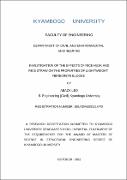| dc.description.abstract | Uganda’s progress towards achieving sustainable growth is curtailed by poor and
limited infrastructure, over 60% of town population live in shantytowns with deprived quality
accommodation and sanitation, 44% of households sleep in one room, the situation is dire in
Kampala where about 70% sleep in one room. About 67 % of Ugandans live in dwellings
with brick walls while 28 % live in dwellings of mud walls reinforced with timber poles. Over
90 % of framed structure in Uganda are built from reinforced concrete structures with bricks/
block infill walls that are heavy thus influencing the type and size of structural members.
Lightweight building materials are in the neighbourhood and plentifully available, their
efficient use in developing decent housing is quite challenging as they are largely unprocessed,
underdeveloped and un-standardised, limiting their prospective. This research focused on use
of Rice Husks (RH) and Rice Straws (RS) in lightweight fibrecrete blocks for benefit of their
reduced weight. In this research, the fibres were alkali-treated using sodium hydroxide
solution prepared by dissolving 15g of the pellets in 1liter of water heated at 100°C for 60
minutes to create surface roughness, expose cellulose to fibre surface and improve fibre/matrix
adhesion. The fibres were then used to prepare 121 fibrecrete blocks of 400x150x200mm
dimensions with varying proportions of 0%, 10%, 20%, 30%, 40%, and 50% of RH and RS
and tested for density, compressive strength, water absorption, thermal conductivity, fire
resistances and microstructure. The densities of lightweight fibrecrete blocks ranged between
(1947-1485) kg/m3 with a reduction of (7.9- 30.5) % compared to control blocks. Compressive
strength of the blocks varied between 1.53 - 5.36N/mm2 for RH blocks and 1.28 - 3.48N/mm2
for RS blocks at 28 days. The loss in compressive strength of lightweight fibrecrete blocks
tested for fire resistance ranged from 10.7- 34.3% and 6.8-73.7% for RH and RS-blocks
respectively while water absorption ranged between (5.8-7.8) % for RH and (6.4-11.3) % for
RS blocks and 3.6% for control blocks. Thermal conductivity improved by (13.4-64.8) %.
Keywords: Rice Husk, Rice Straw, Fibrecrete blocks, lightweight blocks. | en_US |

